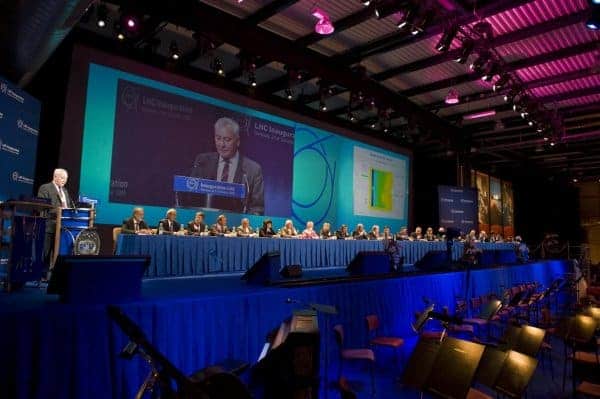
Sharp suits, limos and armed police officers do not normally feature at the CERN particle-physics lab near Geneva. But yesterday dignitaries from some 40 countries descended on the lab to officially inaugurate the Large Hadron Collider (LHC), which circulated its first protons on 10 September. The mammoth security operation saw police — complete with dog — surprising physicists in the control room of the ATLAS detector at 4.15 a.m. on Tuesday, well before the 334 delegates, 130 journalists and more than 500 invited physicists turned up for the afternoon event.
CERN pressed ahead with the inauguration, the largest official delegation it has hosted, despite the LHC having been out of action for the past month. Deep beneath the security tents and cordoned-off roads, the 27 km circumference machine was subject to ongoing investigations into an electrical fault that occurred during testing on 19 September. The incident knocked several 15 m long, 35 tonne dipole bending magnets out of position and released six tonnes of liquid helium into the LHC’s tunnel, which will put the collider out of action until May or June next year.
We’ve gone far enough to know that the LHC works as expected Lyn Evans, CERN
“On 10 September we showed the world what a beautiful machine the LHC is,” project manager Lyn Evans told a 1500-strong audience seated in a giant metal shed off the main CERN site where up to 24 dipole magnets may soon be jostling for repair. “We’ve gone far enough to know that the LHC works as expected.”
Heaping praise
That the LHC should have produced its first proton collisions by now did not appear to dampen the mood of delegates, who heaped high praise on the LHC and CERN as shining examples of human achievement and of European and international collaboration. French prime minister Francois Fillon and Swiss president Pascal Couchepin were joined by ministers and ambassadors from CERN’s 18 other European member states, including the UK’s new science and innovation minister Paul Drayson. The global economic situation, which reached crisis point the very week after the LHC broke down, had not helped efforts to secure heads of state, admitted some CERN officials.
Drayson, a former biotechnology entrepreneur on his first visit to CERN, said he was really impressed. “You get a real sense of the collaborative energy here,” he told Physics World. “We have to continue to support fundamental research like this, which addresses questions about the very nature of matter, whatever the economic conditions.”
You have to have faith that if you try and answer the very big questions then good will come out of it Paul Drayson, UK science and innovation minister
Having earlier been prised from a conversation with a CERN physicist about the LHC’s superconducting technology by his entourage for a prearranged armchair chat with German science minister Annette Schavan, Drayson said that economic return was not all that mattered in science. “You have to have faith that if you try and answer the very big questions then good will come out of it,” he said. “History tells us that strategically you can’t predict discoveries or innovation, and CERN is a living example of that.”
‘Molecular gastronomy’
As the official delegation departed, full of the delights of a 16,000 piece physics-themed buffet of “molecular gastronomy” created by pioneering Italian chef Ettore Bocchia and pondering the debut performance of a 20 minute audiovisual concert by composer Philip Glass and photographer Frans Lanting called “Origins”, more than 2000 CERN physicists arrived by the busload for their own celebration, dubbed “LHCfest”.
Although food and drink flowed rather less freely than it had earlier in the day, during which ranks of safety-glass sporting CERN volunteers dished out ice cream freshly prepared using flasks of liquid nitrogen, LHC-festers were treated to a concert by the inimitable CERN rock group Les Horribles Cernettes and to a live performance of YouTube hit “The Large Hadron Rap”, which saw Evans take to the stage wearing a baseball cap greeted with claps and cheers — a performance that he later described as “a very interesting experience.”




